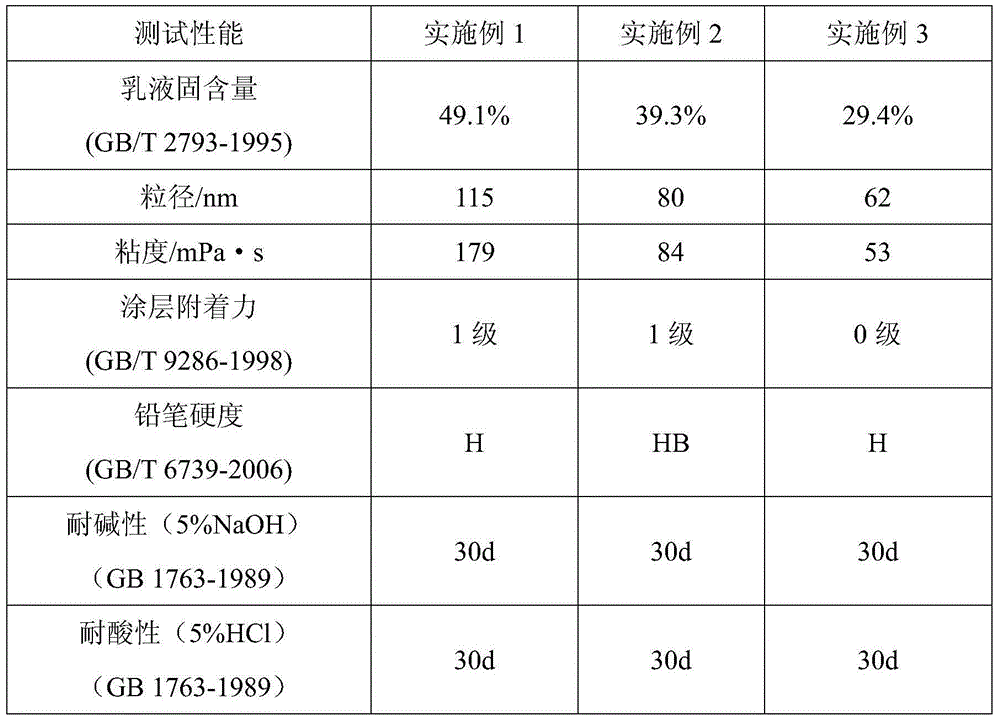Preparation method of nanoparticle-modified polyurethane acrylate copolymer resin microemulsion
A polyurethane acrylate copolymer resin and nanoparticle technology, applied in the direction of coating, etc., to achieve the effect of good wettability, strong permeability and small particle size
- Summary
- Abstract
- Description
- Claims
- Application Information
AI Technical Summary
Problems solved by technology
Method used
Image
Examples
Embodiment 1
[0029] (1) Oil phase: 10 parts of isophorone diisocyanate after dehydration, 41 parts of polyether polyol 210 (functionality is 2, molecular weight is 1000), hydrophobic nano-silica (average particle size is 10nm) 0.02 parts, 0.6 parts of hydroxypropyl acrylate, 5 parts of butyl acrylate, 1.2 parts of n-hexadecane, and 0.1 parts of dibutyltin dilaurate were mixed in an ice-water bath and stirred uniformly for 30 minutes to form an oil phase.
[0030] (2) Water phase: Dissolve 5 parts of sodium dodecylsulfonate and 0.02 parts of potassium persulfate in 100 parts of deionized water, mix and stir in an ice-water bath for 30 minutes to form the water phase;
[0031] (3) Microemulsion polymerization: Mix 50 parts of the oil phase obtained in the above step (1) with 50 parts of the water phase obtained in the step (2), heat up to 60°C under anaerobic conditions, and ultrasonically disperse at a speed of 450 rpm Mechanical stirring, microemulsion polymerization 6h. Then the system i...
Embodiment 2
[0033](1) Oil phase: 10 parts of isophorone diisocyanate after dehydration, 22 parts of polyether polyol 210 (functionality is 2, molecular weight is 1000), hydrophobic nano-zinc oxide (average particle size is 10nm) 0.02 1 part, 6 parts of hydroxyethyl acrylate, 10.5 parts of methyl methacrylate, 2.5 parts of n-hexadecane, and 0.05 part of dibutyltin dilaurate were mixed in an ice-water bath and stirred uniformly for 30 minutes to form an oil phase;
[0034] (2) Water phase: Dissolve 10 parts of sodium didodecylphenyl ether disulfonate and 0.1 part of benzoyl peroxide in 100 parts of deionized water, and mix and stir in an ice-water bath for 30 minutes to form the water phase;
[0035] (3) Microemulsion polymerization: Mix 40 parts of the oil phase obtained in the above step (1) with 60 parts of the water phase obtained in the step (2), and heat up to 80°C under anaerobic conditions, ultrasonically disperse at a speed of 500 rpm Mechanical stirring, microemulsion polymerizati...
Embodiment 3
[0037] (1) Oil phase: 10 parts of dicyclohexylmethane diisocyanate after dehydration, 25 parts of polyether polyol 220 (functionality is 2, molecular weight is 2000), hydrophobic nano silica (average particle diameter is 15nm) ) 0.25 parts, 3.5 parts of hydroxyethyl methacrylate, 27 parts of ethyl acrylate, 0.65 parts of n-hexadecane, and 0.02 parts of dibutyltin dilaurate were mixed in an ice-water bath and stirred uniformly for 30 minutes to form an oil phase;
[0038] (2) Water phase: Dissolve 5 parts of sodium stearate or bis(2-ethylhexyl) sodium succinate sulfonate and 0.02 part of azobisisobutylimidazoline hydrochloride in 100 parts of deionized water, and place on ice Mix and stir in a water bath for 30 minutes to form the water phase;
[0039] (3) Microemulsion polymerization: Mix 30 parts of the oil phase obtained in the above step (1) with 70 parts of the water phase obtained in the step (2), and heat up to 70°C under anaerobic conditions, ultrasonically disperse at ...
PUM
| Property | Measurement | Unit |
|---|---|---|
| particle diameter | aaaaa | aaaaa |
| particle size | aaaaa | aaaaa |
| Functional group degree | aaaaa | aaaaa |
Abstract
Description
Claims
Application Information
 Login to View More
Login to View More - R&D
- Intellectual Property
- Life Sciences
- Materials
- Tech Scout
- Unparalleled Data Quality
- Higher Quality Content
- 60% Fewer Hallucinations
Browse by: Latest US Patents, China's latest patents, Technical Efficacy Thesaurus, Application Domain, Technology Topic, Popular Technical Reports.
© 2025 PatSnap. All rights reserved.Legal|Privacy policy|Modern Slavery Act Transparency Statement|Sitemap|About US| Contact US: help@patsnap.com

